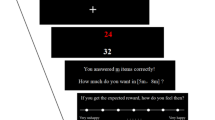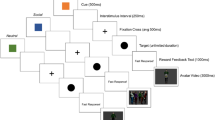Abstract
The schizotypy construct is useful for studying the effects of environmental stress on development of subclinical negative symptoms. The relationship among self-report motivation, effort–reward imbalance (ERI), and schizotypal features has seldom been studied. We aimed to examine the possible moderation effect of schizotypal traits on ERI and reward motivation. Eight-hundred-and-forty-three college students were recruited online to complete a set of self-reported measures capturing schizotypal traits, effort–reward imbalance and reward motivation, namely the Schizotypal Personality Questionnaire (SPQ), the Effort–Reward Imbalance-School Version Questionnaire (C-ERI-S) and the Motivation and Pleasure Scale-Self Report (MAP-SR). We conducted multiple linear regression to construct models to investigate the moderating effects of schizotypal traits on the relationship between ERI and reward motivation. Stressful ERI situation predicted the reduction of reward motivation. Negative schizotypal traits showed a significant negative moderating effect on the relationship between ERI and reward motivation, while positive and disorganized schizotypal traits had significant positive moderating effects. Schizotypal traits subtypes differently moderate the relationship between ERI and reward motivation. Only negative schizotypal traits and stressful ERI situation together have negative impact on reward motivation.

Similar content being viewed by others
References
Foussias G, Remington G (2010) Negative symptoms in schizophrenia: avolition and Occam’s razor. Schizophr Bull 36:359–369. https://doi.org/10.1093/schbul/sbn094
Walker EF, Diforio D (1997) Schizophrenia: a neural diathesis-stress model. Psychol Rev 104:667–685. https://doi.org/10.1037/0033-295X.104.4.667
Walker E, Mittal V, Tessner K (2008) Stress and the hypothalamic pituitary adrenal axis in the developmental course of schizophrenia. Annu Rev Clin Psychol 4:189–216. https://doi.org/10.1146/annurev.clinpsy.4.022007.141248
Pruessner M, Cullen AE, Aas M et al (2017) The neural diathesis-stress model of schizophrenia revisited: an update on recent findings considering illness stage and neurobiological and methodological complexities. Neurosci Biobehav Rev 73:191–218. https://doi.org/10.1016/j.neubiorev.2016.12.013
Eddy P, Wertheim EH, Hale MW et al (2018) A systematic review and meta-analysis of the effort-reward imbalance model of workplace stress and hypothalamic-pituitary-adrenal axis measures of stress. Psychosom Med 80:103–113. https://doi.org/10.1097/PSY.0000000000000505
Siegrist J (1996) Adverse health effects of high-effort/low-reward conditions. J Occup Health Psychol 1:27–41. https://doi.org/10.1037/1076-8998.1.1.27
Williams CJ, Dziurawiec S, Heritage B (2018) More pain than gain: effort–reward imbalance, burnout, and withdrawal intentions within a university student population. J Educ Psychol 110:378–394. https://doi.org/10.1037/edu0000212
Kogler L, Mueller VI, Chang A et al (2015) Psychosocial versus physiological stress—meta-analyses on deactivations and activations of the neural correlates of stress reactions. Neuroimage 119:235–251. https://doi.org/10.1016/j.neuroimage.2015.06.059
Barch DM, Dowd EC (2010) Goal representations and motivational drive in schizophrenia: the role of prefrontal-striatal interactions. Schizophr Bull 36:919–934. https://doi.org/10.1093/schbul/sbq068
Gold JM, Strauss GP, Waltz JA et al (2013) Negative symptoms of schizophrenia are associated with abnormal effort-cost computations. Biol Psychiatry 74:130–136. https://doi.org/10.1016/j.biopsych.2012.12.022
Yan YJ, Huang J, Lui SSY et al (2021) The effect of effort-reward imbalance on brain structure and resting-state functional connectivity in individuals with high levels of schizotypal traits. Cogn Neuropsychiatry 26:166–182. https://doi.org/10.1080/13546805.2021.1899906
Rescorla RA, Wagner AR (1972) A theory of Pavlovian conditioning: variations in the effectiveness of reinforcement and nonreinforcement. In: Black AH, Prokasy WF (eds) Classical conditioning II: current research and theory. Appleton Crofts, New York, pp 64–99
Siegrist J, Menrath I, StöCker T et al (2005) Differential brain activation according to chronic social reward frustration. NeuroReport 16:1899–1903. https://doi.org/10.1097/01.wnr.0000186601.50996.f7
Dobryakova E, DeLuca J, Genova HM et al (2013) Neural correlates of cognitive fatigue: cortico-striatal circuitry and effort-reward imbalance. J Int Neuropsychol Soc 19:849–853. https://doi.org/10.1017/S1355617713000684
Arias-Carrión Ó, Pöppel E (2007) Dopamine, learning, and reward-seeking behavior. Acta Neurobiol Exper 67:481–488
Waugh CE, Gotlib IH (2008) Motivation for reward as a function of required effort: dissociating the ‘liking’ from the ‘wanting’ system in humans. Motiv Emotion 32:323–330. https://doi.org/10.1007/s11031-008-9104-2
McCarthy JM, Treadway MT, Blanchard JJ (2015) Motivation and effort in individuals with social anhedonia. Schizophr Res 165:70–75. https://doi.org/10.1016/j.schres.2015.03.030
Campellone TR, Elis O, Mote J et al (2016) Negative symptoms in psychometrically defined schizotypy: the role of depressive symptoms. Psychiatry Res 240:181–186. https://doi.org/10.1016/j.psychres.2016.04.020
Xie DJ, Shi HS, Lui SSY et al (2018) Cross Cultural validation and extension of the clinical assessment interview for negative symptoms (CAINS) in the Chinese context: evidence from a spectrum perspective. Schizophr Bull 44(Suppl 2):S547–S555. https://doi.org/10.1093/schbul/sby013
Ettinger U, Mohr C, Gooding GC et al (2015) Cognition and brain function in schizotypy: a selective review. Schizophr Bull 41(Suppl 2):S417–S426. https://doi.org/10.1093/schbul/sbu190
Raine A (2006) Schizotypal personality: neurodevelopmental and psychosocial trajectories. Annu Rev Clin Psycho 2:291–326. https://doi.org/10.1146/annurev.clinpsy.2.022305.095318
Wang Y, Yan C, Yin DZ et al (2015) Neurobiological changes of schizotypy: evidence from both volume-based morphometric analysis and resting-state functional connectivity. Schizophr Bull 41(Suppl 2):S444–S454. https://doi.org/10.1093/schbul/sbu178
Wang YM, Cai XL, Zhang RT et al (2020) Altered brain structural and functional connectivity in schizotypy. Psychol Med 17:1–10. https://doi.org/10.1017/S0033291720002445
Polner B, Faiola E, Urquijo MF et al (2019) The network structure of schizotypy in the general population. Eur Arch Psychiatry Clin Neurosci 271:635–645. https://doi.org/10.1007/s00406-019-01078-x
Chan RC, Wang Y, Yan C et al (2012) A study of trait anhedonia in non-clinical Chinese samples: evidence from the Chapman Scales for Physical and Social Anhedonia. PLoS ONE 7:e34275. https://doi.org/10.1371/journal.pone.0034275
Premkumar P, Dunn AK, Onwumere J et al (2019) Sensitivity to criticism and praise predicts schizotypy in the non-clinical population: the role of affect and perceived expressed emotion. Eur Psychiatry 55:109–115. https://doi.org/10.1016/j.eurpsy.2018.10.009
Popovic D, Schmitt A, Kaurani L et al (2019) Childhood Trauma in Schizophrenia: Current Findings and Research Perspectives. Front Neurosci 13:274. https://doi.org/10.3389/fnins.2019.00274
Dedovic K, Renwick R, Mahani NK et al (2005) The Montreal Imaging Stress Task: using functional imaging to investigate the effects of perceiving and processing psychosocial stress in the human brain. J Psychiatr Neurosci 30:319–325. https://doi.org/10.1111/j.1600-079X.2005.00261.x
Soliman A, O’driscoll GA, Pruessner J et al (2008) Stress-induced dopamine release in humans at risk of psychosis: a [11C]raclopride PET study. Neuropsychopharmacology 33:2033–2041. https://doi.org/10.1038/sj.npp.1301597
Soliman A, O’driscoll GA, Pruessner J et al (2011) Limbic response to psychosocial stress in schizotypy: a functional magnetic resonance imaging study. Schizophr Res 131:184–191. https://doi.org/10.1016/j.schres.2011.05.016
Barrantes-Vidal N, Chun CA, Myin-Germeys I et al (2013) Psychometric schizotypy predicts psychotic-like, paranoid, and negative symptoms in daily life. J Abnorm Psychol 122:1077–1087. https://doi.org/10.1037/a0034793
Chapman LJ, Chapman JP (1983) Infrequency scale. Unpublished test
Raine A (1991) The SPQ: a scale for the assessment of schizotypal personality based on DSM-III-R criteria. Schizophrenia Bull 17:555–564. https://doi.org/10.1093/schbul/17.4.555
Chen WJ, Hsiao CK, Lin CCH (1997) Schizotypy in community samples: the three-factor structure and correlation with sustained attention. J Abnorm Psychol 106:649–654. https://doi.org/10.1037/0021-843X.106.4.649
Wang Y, Ettinger U, Meindl T et al (2018) Association of schizotypy with striatocortical functional connectivity and its asymmetry in healthy adults. Hum Brain Mapp 39:288–299. https://doi.org/10.1002/hbm.23842
Yan C, Liu WH, Cao Y et al (2011) Self-reported pleasure experience and motivation in individuals with schizotypal personality disorders proneness. East Asian Arch Psychiatry 21:115–122
Li J, Shang L, Wang T et al (2010) Measuring effort-reward imbalance in school settings: a novel approach and its association with self-rated health. J Epidemiol 20:111–118. https://doi.org/10.2188/jea.JE20090057
Van HN, Le MD, Van TN et al (2018) A systematic review of effort-reward imbalance among health workers. Int J Health Plann Manage 33:e674–e695. https://doi.org/10.1002/hpm.2541
Llerena K, Park SG, McCarthy JM et al (2013) The Motivation and Pleasure Scale-Self-Report (MAP-SR): reliability and validity of a self-report measure of negative symptoms. Compr Psychiatry 54:568–574. https://doi.org/10.1016/j.comppsych.2012.12.001
Wang LL, Ma EPY, Lui SSY et al (2020) Validation and extension of the Motivation and Pleasure Scale-Self Report (MAP-SR) across the schizophrenia spectrum in the Chinese context. Asian J Psychiatr 49:101971. https://doi.org/10.1016/j.ajp.2020.101971
Chmielewski PM, Fernandes LO, Yee CM et al (1995) Ethnicity and gender in scales of psychosis proneness and mood disorders. J Abnorm Psychol 104:464–470. https://doi.org/10.1037/0021-843X.104.3.464
Kerns JG, Docherty AR, Martin EA (2008) Social and physical anhedonia and valence and arousal aspects of emotional experience. J Abnorm Psychol 117:735–746. https://doi.org/10.1037/a0013601
Hu HX, Chu MY, Yang Y et al (2018) Mediation effect of beliefs about pleasure and emotional experience between social anhedonia and prediction of pleasant events. Psychiatry Res 264:39–45. https://doi.org/10.1016/j.psychres.2018.03.070
Vegchel NV, Jonge JD, Bosma H et al (2005) Reviewing the effort-reward imbalance model: drawing up the balance of 45 empirical studies. Soc Sci Med 60:1117–1131. https://doi.org/10.1016/j.socscimed.2004.06.043
Bakker AB, Killmer CH, Siegrist J et al (2010) Effort–reward imbalance and burnout among nurses. J Adv Nurs 31:884–891. https://doi.org/10.1046/j.1365-2648.2000.01361.x
Studer B, Knecht S (2016) A benefit-cost framework of motivation for a specific activity. Prog Brain Res 229:25–47. https://doi.org/10.1016/bs.pbr.2016.06.014
Szily E, Kéri S (2013) Delusion proneness and emotion appraisal in individuals with high psychosis vulnerability. Clin Psychol Psychother 20:166–170. https://doi.org/10.1002/cpp.1763
Horan WP, Brown SA, Blanchard JJ (2007) Social anhedonia and schizotypy: the contribution of individual differences in affective traits, stress, and coping. Psychiatry Res 149:147–156. https://doi.org/10.1016/j.psychres.2006.06.002
Li LY, Karcher NR, Kerns JG et al (2019) The subjective-objective deficit paradox in schizotypy extends to emotion regulation and awareness. J Psychiatr Res 111:160–168. https://doi.org/10.1016/j.jpsychires.2019.01.026
Ruzibiza C, Grattan RE, Eder R et al (2018) Components of schizophrenia liability are not uniformly associated with stress sensitivity, resilience, and coping. Psychiatry Res 260:10–16. https://doi.org/10.1016/j.psychres.2017.11.039
Henry JD, Green MJ, Restuccia C et al (2009) Emotion dysregulation and schizotypy. Psychiatry Res 166:116–124. https://doi.org/10.1016/j.psychres.2008.01.007
Barahmand U, Ahmad RHS (2016) Psychotic-like experiences and psychological distress: the role of resilience. J Am Psychiatr Nurses Assoc 22:312–319. https://doi.org/10.1177/1078390316653802
Docherty NM (1996) Affective reactivity of symptoms as a process discriminator in schizophrenia. J Nerv Ment Dis 184:535–541. https://doi.org/10.1097/00005053-199609000-00004
McEwen BS, Gianaros PJ (2010) Central role of the brain in stress and adaptation: links to socioeconomic status, health, and disease. Ann N Y Acad Sci 1186:190–222. https://doi.org/10.1111/j.1749-6632.2009.05331.x
Ming TT, Stone WS, Tarbox SI et al (2002) An integration of schizophrenia with schizotypy: identification of schizotaxia and implications for research on treatment and prevention. Schizophr Res 54:169–175. https://doi.org/10.1016/S0920-9964(01)00364-4
Grant P, Hennig J (2020) Schizotypy, social stress and the emergence of psychotic-like states—a case for benign schizotypy? Schizophr Res 216:435–442. https://doi.org/10.1016/j.schres.2019.10.052
Werner E (1993) Risk, resilience, and recovery: Perspectives from the Kauai Longitudinal Study. Dev Psychopathol 5:503–515. https://doi.org/10.1017/S095457940000612X
Kwapil TR, Brown LH, Silvia PJ et al (2012) The expression of positive and negative schizotypy in daily life: an experience sampling study. Psychol Med 42:2555–2566. https://doi.org/10.1017/S0033291712000827
Kemp KC, Gross GM, Barrantes-Vidal N et al (2018) Association of positive, negative, and disorganized schizotypy dimensions with affective symptoms and experiences. Psychiatry Res 270:1143–1149. https://doi.org/10.1016/j.psychres.2018.10.031
Yang JC, Quadir B (2018) Individual differences in an English learning achievement system: gaming flow experience, gender differences and learning motivation. Tech Pedago Edu 27:351–366. https://doi.org/10.1080/1475939X.2018.1460618
Acknowledgements
This study was supported by a grant the CAS Key Laboratory of Mental Health of the Institute of Psychology and the Philip K. H. Wong Foundation. The Chinese version of the Effort-reward Imbalance-School Version (C-ERI-S) Questionnaire was developed and provided by Dr. Jian Li.
Author information
Authors and Affiliations
Corresponding authors
Ethics declarations
Conflict of interest
The authors declare that there are no conflicts of interest.
Supplementary Information
Below is the link to the electronic supplementary material.
Rights and permissions
About this article
Cite this article
Yan, Yj., Hu, Hx., Wang, Ll. et al. Negative schizotypal traits predict the reduction of reward motivation in effort–reward imbalance. Eur Arch Psychiatry Clin Neurosci 273, 439–445 (2023). https://doi.org/10.1007/s00406-022-01419-3
Received:
Accepted:
Published:
Issue Date:
DOI: https://doi.org/10.1007/s00406-022-01419-3




